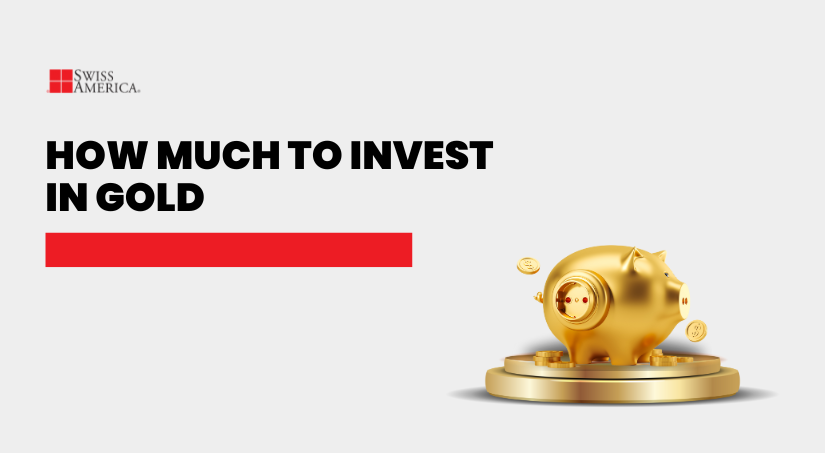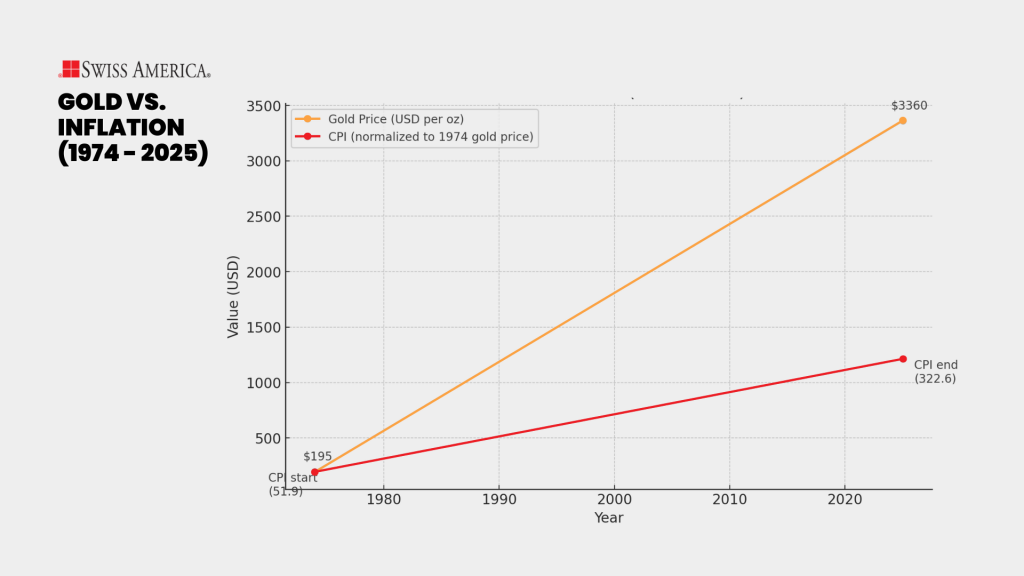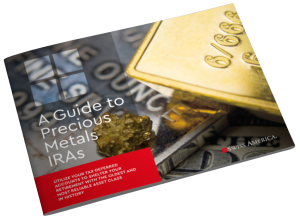
All it takes is one piece of bad news, and everyone flocks to gold. That’s why the Q2 report from World Gold Council shows that global gold demand increased 45% year over year.
If you’re wondering how much to invest in gold this year, this article covers potential allocation strategies. We also cover the different ways you can hold gold and what to consider as part of your overall strategy.
Why buy gold?
Gold is one of the few assets that has held its value through every kind of economic environment. Investors use it to protect their wealth and to own something completely independent. It isn’t tied to a company’s balance sheet or a government’s promises. This precious metal stands on its own.
One of the strongest reasons to hold gold is to protect your wealth. Inflation chips away at the dollar’s purchasing power year after year. Stocks rise and fall. Currencies weaken. Economies move through cycles of boom and bust. Through all of it, gold tends to remain steady when everything else feels uncertain.
Ways to invest in gold
When you think of gold investments, gold bars and coins might be the first thing that comes to your mind. This is the purest way of investing in gold. But you can also invest in gold paper assets like ETFs, stocks, mutual funds, and futures.
Physical gold
If you’re buying gold to invest, it’s going to be gold bullion coins or bars. You might own gold jewelry, but this isn’t really a gold investment. Why? Because it’s not easy to make your money back when you sell. Plus, you’re paying extra costs for details that have nothing to do with gold content.
The benefits of owning gold coins and bars directly include:
- Tangible asset you control
- Not relying on anyone else for your gold investment
- Completely independent of the financial system
- Easy to sell gold bullion anywhere in the world
- Privacy, since no one needs to know you own physical gold
That being said, the drawbacks are that you need to think about insurance and storage costs.
Gold ETFs
Exchange-traded funds invest in gold bullion by pooling investors’ money and allocating shares towards physical gold in a vault. There’s over 100 gold-backed ETFs. Some of the more well-known include SPDR Gold Shares ETF or Sprott Physical Gold Trust.
The main reason for Gold ETFs is that you rely on someone else to take care of storage and insurance. Drawbacks are that you don’t own the actual physical asset and the fees that you’ll pay for active management.
Gold mining stocks
Owning stocks in gold mining companies gives you exposure to increases in gold prices, but there’s other factors that impact their performance. If the company has operational challenges, the stocks may struggle even if the rest of the gold market is up.
Gold stocks start to get you further away from pure gold investing. And, they don’t give you independence from the overall stock market.
Gold mutual funds
Gold mutual funds blend several types of gold investments. This can include stocks in gold mining companies, gold futures contracts, and other gold-related securities. Many investors like the idea of diversified exposure to gold.
The drawback for mutual funds is that they are actively managed by a fund manager, which increases fees and reduces your returns.
Gold futures
Gold futures are a risky way to speculate on prices. These are paper assets where you’re betting on gold prices at a set time in the future. Many investors like them for leverage. You can make quick gains, but you can just as easily lose a lot of money.
How much gold should you own?
Most experts recommend holding gold as a way to reduce portfolio risk. Gold often moves in the opposite direction of other asset classes, so keeping some of your money in gold can help reduce the impact of a financial crisis. Different types of allocations can include:
- 5-10% rule: This has been a common rule ever since President Nixon decoupled gold from the U.S. dollar in 1971. There’s numerous studies on how gold bullion improves overall returns, including recent research recommending allocations as high as 17%.
- 1/3 rule: The 1/3 rule is about diversification within precious metals as a category. It recommends allocating 1/3 of whatever amount you place in metals to be in gold. From there, you’d split the remaining amounts between silver, platinum, or other precious metals.
- Ray Dalio’s “all-weather portfolio”: Ray Dalio introduced the all-weather portfolio in 1996. It recommends allocating 7.5% of your portfolio to physical bullion. The rest of the recommendations include 30% stocks, 55% different types of bonds and 7.5% in other commodities.
- Follow central banks: Most central banks keep about 10%-20% of their cash reserves in gold. You can follow their strategy and check the latest news on World Gold Council’s website.
- Conservative investors: Beginning investors might start with a smaller amount, like 2-5%.
- Moderate investors: If you’re more of a middle-ground investor, you’d allocate 5-10% of your portfolio to gold.
- Aggressive investors: Investors who want to further protect their wealth against economic uncertainty or black swan events could use a 10-15% allocation.
- Gold bugs and inflation hawks: If you’re very bullish on gold or you’re very concerned about inflation, you could look at a 15-25% allocation to gold.
Here’s a summary of these approaches:
| Approach / Type | Allocation range | Details |
| Conservative start | 2–5% | Small safety net for beginners |
| Middle ground | 5–10% | Balanced way to reduce risk |
| Bigger hedge | 10–15% | For those wanting stronger protection |
| Heavy gold focus | 15–25% | For believers in gold or worried about inflation |
| Classic rule of thumb | 5–10% | Long-used guideline |
| 1/3 metals mix | 1/3 of metals | Gold plus silver and platinum |
| All-weather portfolio (Dalio) | 7.5% | From Ray Dalio’s diversified strategy |
| Central bank style | 10–20% | Matches global reserve practices |
Work with your financial advisor to see what makes the most sense for your scenario.
What to consider when investing in gold
There’s a few things you can look at to see if gold makes sense for your investment strategy:
1. Economic conditions
Once you decide to start investing in gold and how much you want to allocate, you’ll want to track what’s happening with the economy. Then, as the value of your gold holdings changes, you might have to rebalance your portfolio to meet your planned allocations.
Some of the changes that impact gold prices are:
- Inflation: During periods of high inflation, gold usually does well because investors buy more to help protect the value of their wealth.
- Interest rates: If rates are high, people usually buy other investments that pay higher returns instead of gold, which doesn’t generate income.
- Currency devaluation: When the US dollar loses value, investors buy gold as an alternative store of value.
- Geopolitical crisis: If there are wars, tariffs, or even natural disasters, people buy gold as a safe haven asset.
As an example of why investors buy gold bullion during inflation, see the below comparison chart:

Personal financial circumstances
You’ll also want to take a look at your overall investment strategy and where you are financially today. Consider your net worth and what would be the right amount of gold to allocate. Factor in the stability of your income and how much you can hold in physical gold that doesn’t generate cash flow.
Gold IRAs and retirement planning
One of the ways that you can invest in physical precious metals is through a self-directed IRA. This works just the same as the traditional or Roth IRA, with a few small differences. First, you’ll work with a precious metals IRA custodian who manages the account. There are also IRS rules around which gold coins or bars you can buy. And finally, once you buy your metals, your custodian stores them in a secure depository until you reach retirement age.
The benefit of investing in gold with this type of retirement account is that you’ll see all the same tax benefits of traditional or Roth IRAs. And, you’ll avoid the higher capital gains tax the IRS normally imposes on gold bars and coins.
Final thoughts on how much to invest in gold
The bottom line is that gold works like an insurance policy. It reduces risk because your entire net worth isn’t tied to one asset class. And, gold’s independence from the financial system makes it one of the best ways to avoid putting all your eggs in one basket.
Connect with the Swiss America team today to learn more about how you can add gold to your portfolio.
Invest in gold: FAQs
Is it really worth it to invest in gold?
Yes. Gold helps many people create diversified portfolios as a way to balance out other investments like the stock market or real estate.
How do beginners buy gold?
To get started, find a reputable dealer, discuss your scenario, and decide which gold bars and coins to buy. Once you receive your gold bullion, securely store it.
Is gold a good investment currently?
Yes it is. As of this writing, gold is over $3,800/oz because investors are nervous about the economy, the dollar, and global crises. Even if those worries ease, new concerns will always come around. Gold remains the safe-haven asset people turn to in those situations.
The information in this post is for informational purposes only and should not be considered tax or legal advice. Please consult with your own tax professionals before making any decisions or taking action based on this information.
